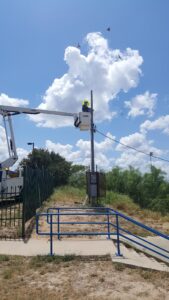
Laredo, Tx- After dormitories closed across the country, a returning college student was forced to complete an online semester using his cellular hotspot, but tightening COVID-19 restrictions and a lack of access to a stable internet connection made life difficult.
Gilberto de Leon, 20, returned home in February to find his parents had ended their internet service because of the increasingly unaffordable fees. De Leon was left to contemplate how he could complete his online coursework without the internet.
A 2017 study by the National Digital Inclusion Alliance, ranked Laredo as the worst-connected US city. Out of 70,522 households documented in Laredo, 22,767 reported they lacked internet access.
De Leon’s lectures would freeze and the slow connection made it impossible to use video conferencing software. The simple task of submitting an assignment could take up to 20 minutes, leading De Leon to rely on public WiFi. Shortly after, the City of Laredo Mayor Pete Saenz closed public facilities including public libraries and recreation centers. De Leon’s access to a stable internet connection and by extension education had been closed.
According to the US Census Bureau, 36.9% of households in Laredo lack internet access. Oscar Armando Lopez Jr. III, a former Google public policy fellow, explains income inequality is the main barrier to securing at-home internet access in Laredo.
“Laredo has a poverty rate higher than the national average,” said Lopez. “If people are facing financial insecurity, their immediate goal is to put food on the table. An internet subscription may not be in the budget, to begin with.”
Despite the financial strain, De Leon’s family reinstalled internet access, after two months.
“It has become a necessity, [in the same way] as the light and water bill,” said Leon. “We need it for work and school.”
Homero Vasquez, director of the Information Services and Telecommunications Department (ITS), said the Laredo City Council recognized internet insecurity could pose a problem as schools switched to online learning. When asked, Vasquez was unable to specify how many individuals were affected as preliminary research had not been gathered.
In early June, the city approved plans to install 54 Wi-Fi units, each costing $1,100, near public facilities where higher rates of school-age children reported lacking internet access. Vasquez estimates the City Council has invested up to $250,000.
Access to WiFi in public facilities would create a safety net for students like De Leon who were left without internet access once local restrictions were enforced.
The city has yet to analyze data usage to determine if additional units are needed. Vasquez said public WiFi is not an end-all solution but a start.
Vasquez said each unit will require maintenance and an internet subscription, costing the city $2,000 a month. The project was funded using COVID-19 relief funds granted by the federal government under the CARES Act. These funds will run out by the end of December, posing a different concern for Vasquez: longevity.
Lopez sees the city’s WiFi initiative as a great first step to closing the digital divide. But believes three prevalent areas remain: connectivity issues, lower at home internet rates, and accurate data.
“Until we have accurate data on the situation and what the problem areas are it would be hard to come up with precise solutions for this issue,” said Lopez.








